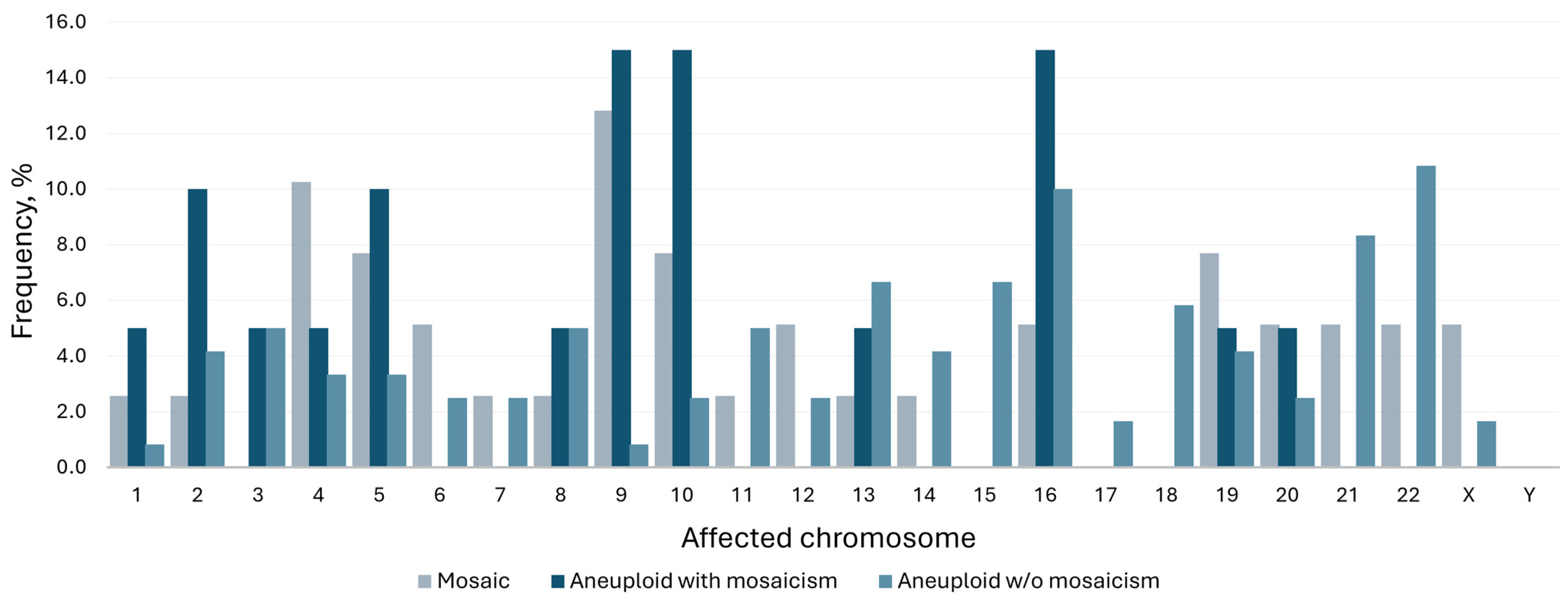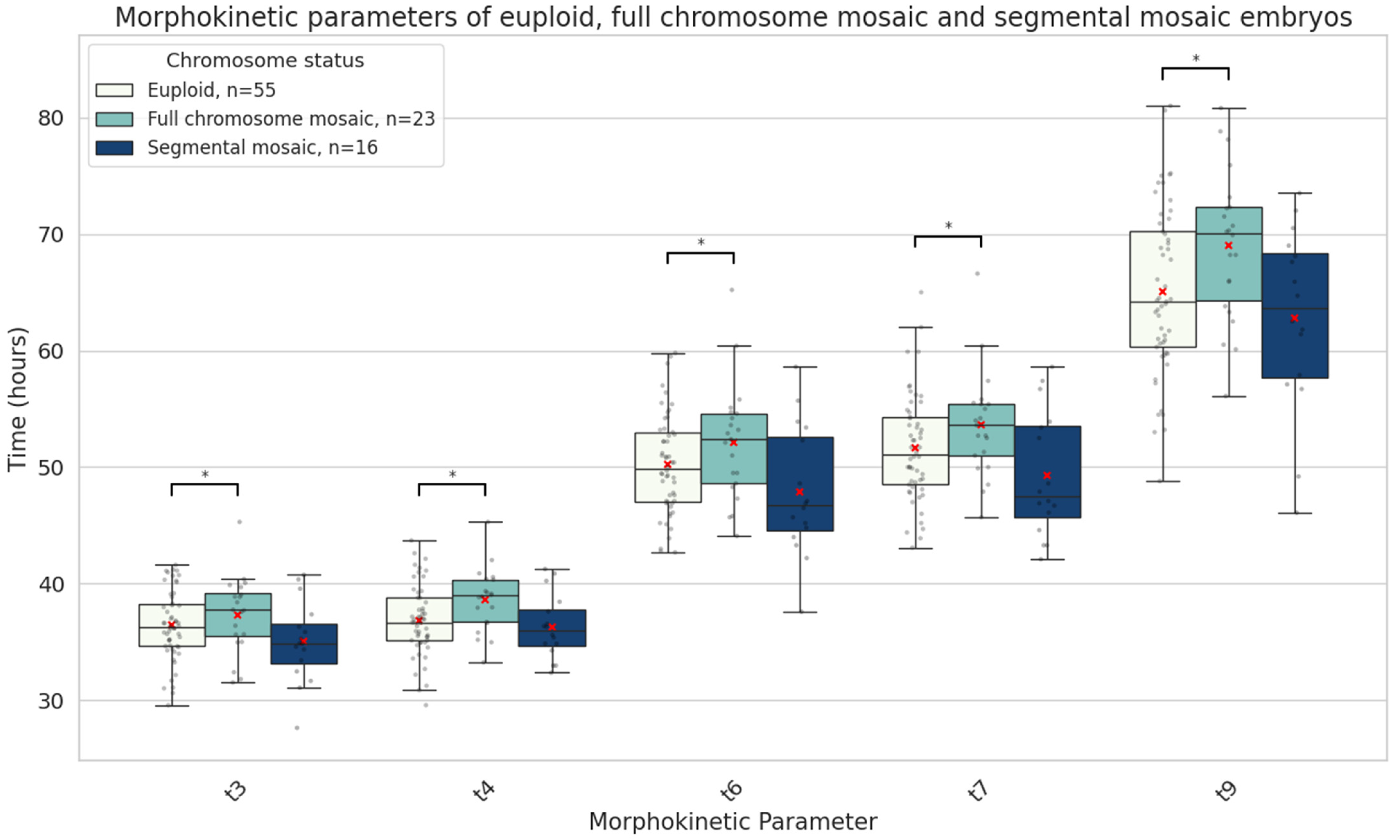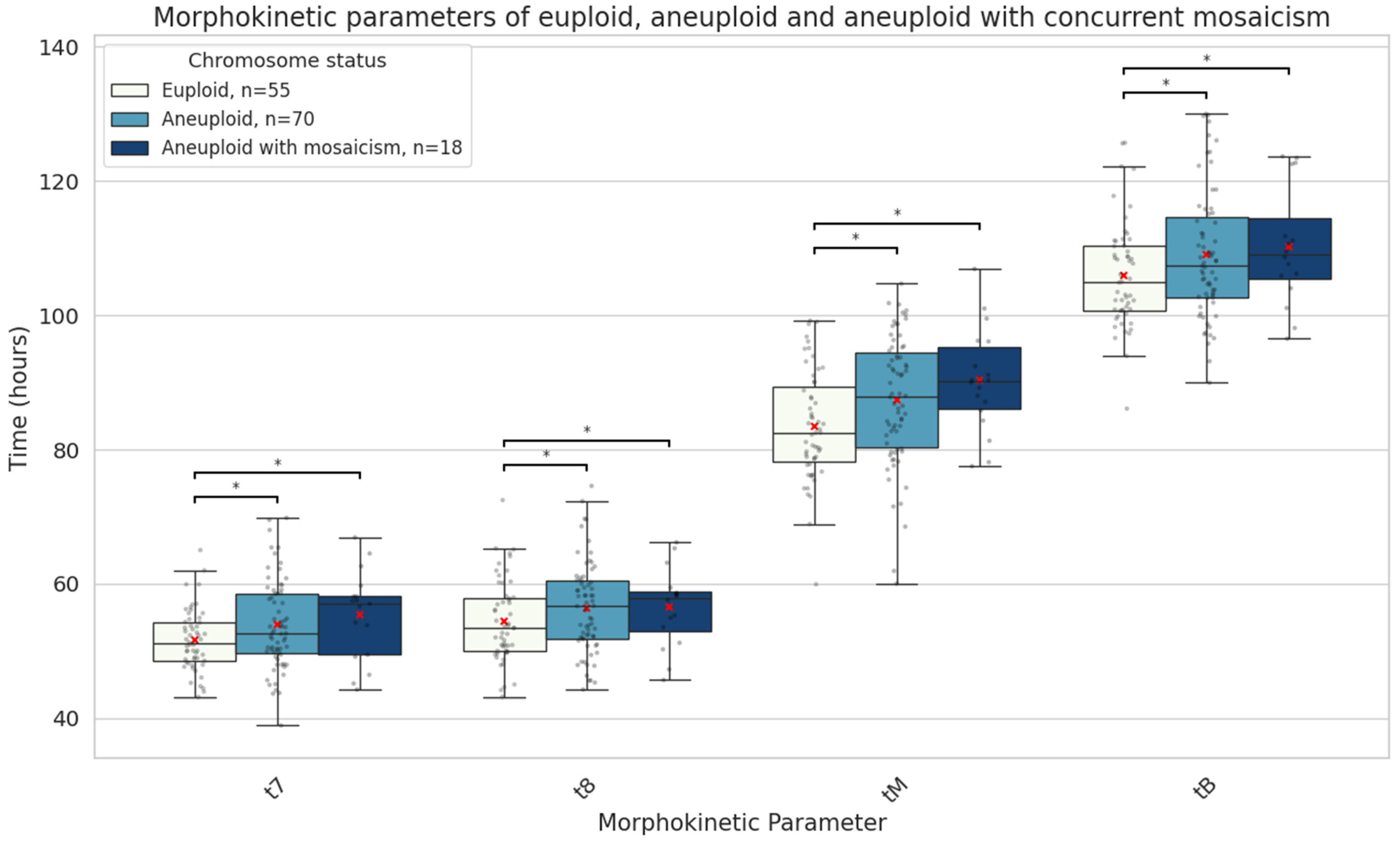Distinct Morphokinetic Signature of Human Embryos with Chromosomal Mosaicism
Abstract
1. Introduction
2. Materials and Methods
2.1. Ethical Approval
2.2. Patients
2.3. Oocyte Retrieval, Embryo Culture
2.4. Evaluation of Time-Lapse Imaging and Morphokinetic Parameters
2.5. NGS-Based Preimplantation Genetic Testing for Chromosomal Abnormalities (PGT-A)
2.6. Statistical Analysis
3. Results
3.1. Study Population
3.2. Mosaic vs. Euploid
3.3. Aneuploid with Mosaic vs. Euploid
4. Discussion
5. Conclusions
Supplementary Materials
Author Contributions
Funding
Institutional Review Board Statement
Informed Consent Statement
Data Availability Statement
Conflicts of Interest
Abbreviations
| PGT-A | Preimplantation Genetic Testing for Aneuploidy |
| NGS | Next-Generation Sequencing |
| TLM | Time-Lapse Monitoring |
| SNV | Single Nucleotide Variant |
| CNV | Copy Number Variant |
| ART | Assisted Reproductive Therapy |
| IVF | In Vitro Fertilization |
| ICSI | Intracytoplasmic Sperm Injection |
| ICM | Inner Cell Mass |
| TE | Trophectoderm |
| hCG | Human Chorionic Gonadotropin |
| t0 | Time of Sperm Microinjection |
| tPNf | Time of Pronuclei Fading |
| t2–t9 | Timepoints of Cleavage to 2–9 Cells |
| tM | Time of Morula Formation |
| tSB | Time of Start of Blastulation |
| tB | Time of Full Blastocyst Formation |
| D5/D6 | Day 5/Day 6 of Embryo Development |
| SD | Standard Deviation |
| CI | Confidence Interval |
| UPD | Uniparental Disomy |
| Mb | Megabase |
References
- Moog, U.; Felbor, U.; Has, C.; Zirn, B. Disorders caused by genetic mosaicism. Dtsch. Arztebl. Int. 2020, 116, 119–125. [Google Scholar] [CrossRef] [PubMed]
- Martínez-Glez, V.; Tenorio, J.; Nevado, J.; Gordo, G.; Rodríguez-Laguna, L.; Feito, M.; de Lucas, R.; Pérez-Jurado, L.A.; Pérez, V.L.R.; Torrelo, A.; et al. A six-attribute classification of genetic mosaicism. Genet. Med. 2020, 22, 1743–1757. [Google Scholar] [CrossRef] [PubMed]
- Zhai, F.; Kong, S.; Song, S.; Guo, Q.; Ding, L.; Zhang, J.; Wang, N.; Kuo, Y.; Guan, S.; Yuan, P.; et al. Human embryos harbor complex mosaicism with broad presence of aneuploid cells during early development. Cell Discov. 2024, 10, 98. [Google Scholar] [CrossRef]
- Popovic, M.; Dhaenens, L.; Boel, A.; Menten, B.; Heindryckx, B. Chromosomal mosaicism in human blastocysts: The ultimate diagnostic dilemma. Hum. Reprod. Update 2020, 26, 313–334. [Google Scholar] [CrossRef] [PubMed]
- Munné, S.; Spinella, F.; Grifo, J.; Zhang, J.; Beltran, M.P.; Fragouli, E.; Fiorentino, F. Clinical outcomes after the transfer of blastocysts characterised as mosaic by high resolution Next Generation Sequencing—further insights. Eur. J. Med. Genet. 2020, 63, 103741. [Google Scholar] [CrossRef]
- Coticchio, G.; Barrie, A.; Lagalla, C.; Borini, A.; Fishel, S.; Griffin, D.; Campbell, A. Plasticity of the human preimplantation embryo: Developmental dogmas, variations on themes and self-correction. Hum. Reprod. Update 2021, 27, 848–865. [Google Scholar] [CrossRef]
- Viotti, M.; Victor, A.R.; Barnes, F.L.; Zouves, C.G.; Besser, A.G.; Grifo, J.A.; Cheng, E.-H.; Lee, M.-S.; Horcajadas, J.A.; Corti, L.; et al. Using outcome data from one thousand mosaic embryo transfers to formulate an embryo ranking system for clinical use. Fertil. Steril. 2021, 115, 1212–1224. [Google Scholar] [CrossRef]
- Hong, B.; Hao, Y. The outcome of human mosaic aneuploid blastocysts after intrauterine transfer: A retrospective study. Medicine 2020, 99, e18768. [Google Scholar] [CrossRef]
- Capalbo, A.; Poli, M.; Rienzi, L.; Girardi, L.; Patassini, C.; Fabiani, M.; Cimadomo, D.; Benini, F.; Farcomeni, A.; Cuzzi, J.; et al. Mosaic human preimplantation embryos and their developmental potential in a prospective, non-selection clinical trial. Am. J. Hum. Genet. 2021, 108, 2238–2247. [Google Scholar] [CrossRef] [PubMed]
- Sciorio, R. Use of time-lapse monitoring in medically assisted reproduction treatments: A mini-review. Zygote 2021, 29, 93–101. [Google Scholar] [CrossRef]
- Gardner, D.K.; Schoolcraft, W.B. In vitro culture of human blastocysts. In Towards Reproductive Certainty: Fertility and Genetics Beyond; Jansen, R., Mortimer, D., Eds.; Parthenon Press: Carnforth, Lancashire, UK, 1999; pp. 378–388. [Google Scholar]
- McCoy, R.C. Mosaicism in preimplantation human embryos: When chromosomal abnormalities are the norm. Trends Genet. 2017, 33, 448–463. [Google Scholar] [CrossRef]
- McCoy, R.C.; Summers, M.C.; McCollin, A.; Ottolini, C.S.; Ahuja, K.; Handyside, A.H. Meiotic and mitotic aneuploidies drive arrest of in vitro fertilized human preimplantation embryos. Genome Med. 2023, 15, 77. [Google Scholar] [CrossRef]
- Martín, Á.; Mercader, A.; Dominguez, F.; Quiñonero, A.; Perez, M.; Gonzalez-Martin, R.; Delgado, A.; Mifsud, A.; Pellicer, A.; De Los Santos, M.J. Mosaic results after preimplantation genetic testing for aneuploidy may be accompanied by changes in global gene expression. Front. Mol. Biosci. 2023, 10, 1180689. [Google Scholar] [CrossRef]
- Popovic, M.; Dhaenens, L.; Taelman, J.; Dheedene, A.; Bialecka, M.; De Sutter, P.; Chuva de Sousa Lopes, S.M.; Menten, B.; Heindryckx, B. Extended in vitro culture of human embryos demonstrates the complex nature of diagnosing chromosomal mosaicism from a single trophectoderm biopsy. Hum. Reprod. 2019, 34, 758–769. [Google Scholar] [CrossRef] [PubMed]
- Kahraman, S.; Cetinkaya, M.; Yuksel, B.; Yesil, M.; Pirkevi Cetinkaya, C. The birth of a baby with mosaicism resulting from a known mosaic embryo transfer: A case report. Hum. Reprod. 2020, 35, 727–733. [Google Scholar] [CrossRef]
- Schlade-Bartusiak, K.; Strong, E.; Zhu, O.; Mackie, J.; Salema, D.; Volodarsky, M.; Roberts, J.; Steinraths, M. Mosaic embryo transfer—First report of a live born with nonmosaic partial aneuploidy and uniparental disomy 15. F S Rep. 2022, 3, 192–197. [Google Scholar] [CrossRef]
- Greco, E.; Yakovlev, P.; Kornilov, N.; Vyatkina, S.; Bogdanova, D.; Ermakova, M.; Tarasova, Y.; Tikhonov, A.; Pendina, A.; Biricik, A.; et al. Two clinical case reports of embryonic mosaicism identified with PGT-A persisting during pregnancy as true fetal mosaicism. Hum. Reprod. 2023, 38, 315–323. [Google Scholar] [CrossRef] [PubMed]
- Victor, A.R.; Griffin, D.K.; Brake, A.J.; Tyndall, J.C.; Murphy, A.E.; Lepkowsky, L.T.; Lal, A.; Zouves, C.G.; Barnes, F.L.; McCoy, R.C.; et al. Assessment of aneuploidy concordance between clinical trophectoderm biopsy and blastocyst. Hum. Reprod. 2019, 34, 181–192. [Google Scholar] [CrossRef] [PubMed]
- Navratil, R.; Horak, J.; Hornak, M.; Kubicek, D.; Balcova, M.; Tauwinklova, G.; Travnik, P.; Vesela, K. Concordance of various chromosomal errors among different parts of the embryo and the value of re-biopsy in embryos with segmental aneuploidies. Mol. Hum. Reprod. 2020, 26, 269–276. [Google Scholar] [CrossRef]
- Armstrong, S.; Bhide, P.; Jordan, V.; Pacey, A.; Marjoribanks, J.; Farquhar, C. Time-lapse systems for embryo incubation and assessment in assisted reproduction. Cochrane Database Syst. Rev. 2019, 2019, CD011320. [Google Scholar] [CrossRef]
- Bhide, P.; Chan, D.Y.L.; Lanz, D.; Alqawasmeh, O.; Barry, E.; Baxter, D.; Gonzalez Carreras, F.; Choudhury, Y.; Cheong, Y.; Chung, J.P.W.; et al. Clinical effectiveness and safety of time-lapse imaging systems for embryo incubation and selection in in-vitro fertilisation treatment (TILT): A multicentre, three-parallel-group, double-blind, randomised controlled trial. Lancet 2024, 404, 256–265. [Google Scholar] [CrossRef]
- Zou, Y.; Pan, Y.; Ge, N.; Xu, Y.; Gu, R.; Li, Z.; Fu, J.; Gao, J.; Sun, X.; Sun, Y. Can the combination of time-lapse parameters and clinical features predict embryonic ploidy status or implantation? Reprod. Biomed. Online 2022, 45, 643–651. [Google Scholar] [CrossRef] [PubMed]
- Yuan, Z.; Yuan, M.; Song, X.; Huang, X.; Yan, W. Development of an artificial intelligence based model for predicting the euploidy of blastocysts in PGT-A treatments. Sci. Rep. 2023, 13, 2322. [Google Scholar] [CrossRef]
- Jiang, V.S.; Bormann, C.L. Noninvasive genetic screening: Current advances in artificial intelligence for embryo ploidy prediction. Fertil. Steril. 2023, 120, 228–234. [Google Scholar] [CrossRef] [PubMed]
- De Rycke, M.; Capalbo, A.; Coonen, E.; Coticchio, G.; Fiorentino, F.; Goossens, V.; Mcheik, S.; Rubio, C.; Sermon, K.; Sfontouris, I.; et al. ESHRE survey results and good practice recommendations on managing chromosomal mosaicism. Hum. Reprod. Open 2022, 2022, hoac044. [Google Scholar] [CrossRef]
- Popovic, M.; Borot, L.; Lorenzon, A.R.; Lopes, A.L.R.C.; Sakkas, D.; Lledó, B.; Morales, R.; Ortiz, J.A.; Polyzos, N.P.; Parriego, M.; et al. Implicit bias in diagnosing mosaicism amongst preimplantation genetic testing providers: Results from a multicenter study of 36,395 blastocysts. Hum. Reprod. 2024, 39, 258–274. [Google Scholar] [CrossRef] [PubMed]
- Chuang, T.H.; Chang, Y.P.; Lee, M.J.; Wang, H.L.; Lai, H.H.; Chen, S.U. The Incidence of Mosaicism for Individual Chromosome in Human Blastocysts Is Correlated With Chromosome Length. Front. Genet. 2021, 11, 565348. [Google Scholar] [CrossRef]
- Ai, X.; Shi, Y.; Liu, L.-W.; Xu, Y.; Zhang, H.; Liu, Y.; Wang, J.; Ding, C.; Cai, B.; Zhou, C.; et al. Risk factors related to chromosomal mosaicism in human blastocysts. Reprod. Biomed. Online 2022, 45, 640–650. [Google Scholar] [CrossRef]
- Jeon, M.S.; Kim, M.J.; Choi, N.; Hong, J.; Choi, R.; Jeong, Y.; Lee, H.-S.; Lee, K.A.; Yu, E.J.; Kang, I.S. Spectrum of Various Mosaicism Types According to Female Age: An Analysis of 36,506 Blastocysts Using Preimplantation Genetic Testing for Aneuploidy. Biomedicines 2025, 13, 2380. [Google Scholar] [CrossRef]
- Martín, Á.; Rodrigo, L.; Beltrán, D.; Meseguer, M.; Rubio, C.; Mercader, A.; de Los Santos, M.J. The morphokinetic signature of mosaic embryos: Evidence in support of their own genetic identity. Fertil. Steril. 2021, 116, 165–173. [Google Scholar] [CrossRef]
- De Martin, H.; Bonetti, T.C.S.; Nissel, C.A.Z.; Gomes, A.P.; Fujii, M.G.; Monteleone, P.A.A. Association of early cleavage, morula compaction and blastocysts ploidy of IVF embryos cultured in a time-lapse system and biopsied for genetic test for aneuploidy. Sci. Rep. 2024, 14, 739. [Google Scholar] [CrossRef]
- Zhang, Y.X.; Chen, J.J.; Nabu, S.; Yeung, Q.S.Y.; Li, Y.; Tan, J.H.; Suksalak, W.; Chanchamroen, S.; Quangkananurug, W.; Wong, P.S.; et al. The pregnancy outcome of mosaic embryo transfer: A prospective multicenter study and meta-analysis. Genes 2020, 11, 973. [Google Scholar] [CrossRef] [PubMed]
- Greco, E.; Minasi, M.G.; Fiorentino, F. Healthy babies after intrauterine transfer of mosaic aneuploid blastocysts. N. Engl. J. Med. 2015, 373, 2089–2090. [Google Scholar] [CrossRef]
- Victor, A.R.; Tyndall, J.C.; Brake, A.J.; Lepkowsky, L.T.; Murphy, A.E.; Griffin, D.K.; McCoy, R.C.; Barnes, F.L.; Zouves, C.G.; Viotti, M. One hundred mosaic embryos transferred prospectively in a single clinic: Exploring when and why they result in healthy pregnancies. Fertil. Steril. 2019, 111, 280–293. [Google Scholar] [CrossRef]
- Zou, Y.; Sui, Y.; Fu, J.; Ge, N.; Sun, X.; Sun, Y. The morphokinetic signature of human blastocysts with mosaicism and the clinical outcomes following transfer of embryos with low-level mosaicism. J. Ovarian Res. 2024, 17, 10. [Google Scholar] [CrossRef]
- McCoy, R.C.; Demko, Z.P.; Ryan, A.; Banjevic, M.; Hill, M.; Sigurjonsson, S.; Rabinowitz, M.; Petrov, D.A. Evidence of selection against complex mitotic-origin aneuploidy during preimplantation development. PLoS Genet. 2015, 11, e1005601. [Google Scholar] [CrossRef]
- Lagalla, C.; Tarozzi, N.; Sciajno, R.; Wells, D.; Di Santo, M.; Nadalini, M.; Distratis, V.; Borini, A. Embryos with morphokinetic abnormalities may develop into euploid blastocysts. Reprod. Biomed. Online 2017, 34, 137–146. [Google Scholar] [CrossRef] [PubMed]
- Orvieto, R.; Shimon, C.; Rienstein, S.; Jonish-Grossman, A.; Shani, H.; Aizer, A. Do human embryos have the ability of self-correction? Reprod. Biol. Endocrinol. 2020, 18, 98. [Google Scholar] [CrossRef]
- Campos, G.; Sciorio, R.; Fleming, S. Healthy live births after the transfer of mosaic embryos: Self-correction or PGT-A overestimation? Genes 2023, 15, 18. [Google Scholar] [CrossRef]
- Wang, X.; Zhao, J.; Yao, Z.; Xia, Q.; Chang, T.; Zeng, J.; Liu, J.; Li, Y.; Zhu, H. Arrested cells/cellular debris expelled from blastocysts is self-correction phenomenon during early embryonic development. Reprod. Sci. 2023, 30, 2177–2187. [Google Scholar] [CrossRef] [PubMed]
- Xu, J.; Zhang, M.; Niu, W.; Yao, G.; Sun, B.; Bao, X.; Wang, L.; Du, L.; Sun, Y. Genome-wide uniparental disomy screen in human discarded morphologically abnormal embryos. Sci. Rep. 2015, 5, 12302. [Google Scholar] [CrossRef] [PubMed]
- Gueye, N.A.; Devkota, B.; Taylor, D.; Pfundt, R.; Scott, R.T., Jr.; Treff, N.R. Uniparental disomy in the human blastocyst is exceedingly rare. Fertil. Steril. 2014, 101, 232–236. [Google Scholar] [CrossRef] [PubMed]






| Characteristic | Euploid (n = 55) | Mosaic (n = 39) | Aneuploid w/o Mosaic (n = 70) | Aneuploid with Mosaic (n = 18) | p Value |
|---|---|---|---|---|---|
| Maternal age, years | 33.7 ± 4.4 | 34.6 ± 4.1 | 38.3 ± 5.3 * | 37.3 ± 4.1 * | 0.037 1 |
| ART indication | 0.024 2 | ||||
| Unexplained infertility, n (%) | 21 (38.2%) | 21 (53.8%) | 46 (65.7%) * | 12 (66.7%) * | |
| Tubal factor, n (%) | 14 (25.5%) | 4 (10.3%) | 6 (8.6%) * | 0 (0.0%) * | |
| Male factor, n (%) | 17 (30.9%) | 13 (33.3%) | 15 (21.4%) | 6 (33.3%) | |
| Other ‡, n (%) | 3 (5.5%) | 1 (2.6%) | 3 (4.3%) | 0 (0.0%) | |
| ICM morphology grade Grade A, n (%) Grade B, n (%) Grade C, n (%) | 26 (47.3%) 28 (50.9%) 1 (1.8%) | 17 (43.6%) 20 (51.3%) 2 (5.1%) | 13 (18.6%) * 55 (78.6%) 2 (2.8%) | 9 (50.0%) 8 (44.4%) 1 (5.6%) | 0.026 2 |
| TE morphology grade Grade A, n (%) Grade B, n (%) Grade C, n (%) | 3 (5.5%) 48 (87.3%) 4 (7.3%) | 1 (2.6%) 33 (84.6%) 5 (12.8%) | 2 (2.9%) 56 (80.0%) 12 (17.1%) * | 1 (5.6%) 13 (72.2%) * 4 (22.2%) * | 0.041 2 |
Disclaimer/Publisher’s Note: The statements, opinions and data contained in all publications are solely those of the individual author(s) and contributor(s) and not of MDPI and/or the editor(s). MDPI and/or the editor(s) disclaim responsibility for any injury to people or property resulting from any ideas, methods, instructions or products referred to in the content. |
© 2025 by the authors. Licensee MDPI, Basel, Switzerland. This article is an open access article distributed under the terms and conditions of the Creative Commons Attribution (CC BY) license (https://creativecommons.org/licenses/by/4.0/).
Share and Cite
Ruseva, M.; Zlatanova, S.; Nikolova, S.; Tihomirova, T.; Parvanov, D.; Ganeva, R.; Handzhiyska, M.; Safir, J.; Metodiev, D.; Pancheva, M.; et al. Distinct Morphokinetic Signature of Human Embryos with Chromosomal Mosaicism. Genes 2025, 16, 1388. https://doi.org/10.3390/genes16111388
Ruseva M, Zlatanova S, Nikolova S, Tihomirova T, Parvanov D, Ganeva R, Handzhiyska M, Safir J, Metodiev D, Pancheva M, et al. Distinct Morphokinetic Signature of Human Embryos with Chromosomal Mosaicism. Genes. 2025; 16(11):1388. https://doi.org/10.3390/genes16111388
Chicago/Turabian StyleRuseva, Margarita, Sophia Zlatanova, Stefka Nikolova, Teodora Tihomirova, Dimitar Parvanov, Rumiana Ganeva, Maria Handzhiyska, Jinahn Safir, Dimitar Metodiev, Maria Pancheva, and et al. 2025. "Distinct Morphokinetic Signature of Human Embryos with Chromosomal Mosaicism" Genes 16, no. 11: 1388. https://doi.org/10.3390/genes16111388
APA StyleRuseva, M., Zlatanova, S., Nikolova, S., Tihomirova, T., Parvanov, D., Ganeva, R., Handzhiyska, M., Safir, J., Metodiev, D., Pancheva, M., Serafimova, M., Rukova, B., Staneva, R., Stamenov, G., & Hadjidekova, S. (2025). Distinct Morphokinetic Signature of Human Embryos with Chromosomal Mosaicism. Genes, 16(11), 1388. https://doi.org/10.3390/genes16111388






